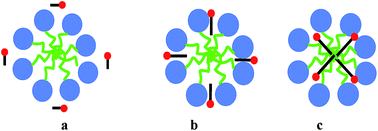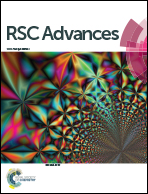Microstructural transition of aqueous CTAB micelles in the presence of long chain alcohols
Abstract
The effect of long chain alcohols (C9OH–C12OH) on the micellar properties of CTAB in the presence of an inorganic salt, KBr, has been systematically studied by viscometry, rheology, DLS and the direct imaging technique, i.e. cryo-TEM. The molar ratio of CTAB/KBr was fixed at 1 : 1 and the alcohol concentration ranged from 0.005 to 0.03 M. With an increase in concentration of the alcohol, the Mitchell–Ninham surfactant parameter, Rp, increases, which favours micellar growth. The viscosity results showed a maxima followed by a drop (regions I–III). In region I, the samples were less viscous and have a propensity to form short cylindrical micelles. The rheological response of the samples in the plateau region (region II) showed strong viscoelasticity, indicating the presence of worm-like micelles, which was confirmed by cryo-TEM and DLS analysis. A drop in viscosity (region III) was observed at higher concentrations of alcohol. The observed increase in the apparent hydrodynamic diameter of the micelles with the concentration of alcohol confirmed the alcohol induced micelle growth. An unusual temperature response was another feature noticed for the C9OH samples in region III, and the cryo-TEM investigation revealed the presence of vesicles, which are nearly absent in C10–C12OH. Therefore, the results suggest a strong dependence of the surfactant morphology on the solubilisation site of the added alcohol, which could be further affected by temperature.


 Please wait while we load your content...
Please wait while we load your content...